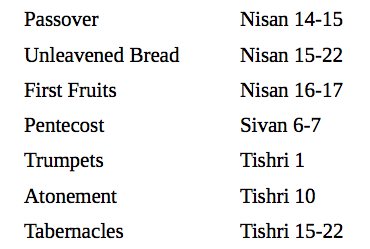 mo’ed mo’adim chatzi
mo’ed mo’adim chatzi
The Lord gave Moses instructions on Mt. Sinai to worship Him through the observance of the mo’adim or “Feasts of the Lord.” These Feasts were appointed in time, as well as space. Seven times a year, every male in Israel was to congregate at the appointed place, i.e., the tabernacle and later the temple, on their appointed date on the calendar.

These seven holy assemblies found in Leviticus 23 are called in Hebrew, the Mo’adim.
- mo’ed is the tent of meeting, i.e. the “appointed place” in the Torah
- mo’adim is the plural and means the appointed times or the appointed feast days.
In Daniel 12:7 in the Hebrew it says, “mo’ed mo’adim chatzi.” The literal reading would be appointed, appointed(s) and half an appointed.
6 And I said to the man clothed in linen, who was above the waters of the stream, “How long shall it be till the end of these wonders?” 7 The man clothed in linen, who was above the waters of the stream, raised his right hand and his left hand toward heaven; and I heard him swear by him who lives for ever that it would be for a time, two times, and half a time; and that when the shattering of the power of the holy people comes to an end all these things would be accomplished. Dan. 12:7
One has to ask what does Daniel mean “it would be for”? The “it” is the shattering of the holy people. This “shattering” occurs until what the Lord intends is accomplished, then the shattering will end. This is clearly in the context of the passage of time. Here, Daniel is telling us that a passage (of time) will entail the punishment of Israel until it is accomplished. We now need to determine, if possible, what the length of this appointed time will be.
FYI: chatzi is half
The Appointed Time
This amount of “appointed” is referenced seven times total in Daniel and The Revelation.
- Once as “time, times and a dividing of time” [Dan 7:25]
- Twice as “time, times and a half time.” [Dan 12:7; Rev 12:14]
- Twice as “forty-two months” [Rev 11:2; 13:5] [42 months of 30 days per lunar month is the equivalent of 1260 days]
- Twice as “twelve hundred and sixty days” [Rev.11:3, 12:6 ]
Although the words can mean “appointed place,” i.e. the tabernacle/temple, it is clear that in Dan 12:7 it is “time”. The English translators did not translate this as “feast, feasts and half” a feast.
The noun mo’ed appears twice, once in the singular and once in the plural. In Hebrew grammar, this is called a double forte with a plural on the second noun. Usually this means that the noun is great, grand, fabulous, or IMPORTANT. The same is accomplished in English by modifying the noun with much, very, or surely. However, all translators have felt that this is a specific time reference rather than just the “really important time”.
Historicists believe a day is symbolically “put” for a year. (See Also; Hermeneutics) A Time in prophecy is interpreted as a year and time, times and half a time works out to 1260 years.
Each time passages in Daniel and The Revelation are about how long the persecution of God’s people will last. The reference to time, times and half a time in the book of Daniel is for the Jews. The reference to time, times and half a time in the book of The Revelation is for the Christians, first to the believing Jew and then to the Gentile. God has made no distinction between Jews and Gentiles, all are His children. [Gal. 3:28]. All have been idolatrous. And as such, all share in His time, times and half a time judgement.
Consequences of Hermeneutics
The futurist will have us believe that this is about a future time of 3 1/2 or 7 years. This hardly makes sense since this period is said to wear to the saints.
He shall speak words against the Most High, and shall wear out the saints of the Most High, and shall think to change the times and the law; and they shall be given into his hand for a time, two times, and half a time. Dan. 7:25
How can God’s people be worn out in just seven years? History shows that the Jews suffered in the Babylonian exile for 70 years. They were not worn out. The Christians were severely tortured under Roman Emperor persecutions which lasted 10 years under Emperor Diocletian from 303 – 313AD. The Church was not “worn out”. These persecutions, though arduous, did not wear out the saints. However, the INQUISITION lasted some 400 years, and took a great toll on God’s people. They were warn out. In May of 1514 the Fifth Lateran Council issued a challenged to anyone who still refused to obey the pope, to come forward. No one came out. The pope and the council celebrated, banquets were held and further laws against heresy were made. However 3 1/2 years Luther posted his 95 Theses. [Rev 10:9] The gates of hell did not prevail, but at a huge cost.
The Years
The post-modern church has lost some simple facts from our history. From the time the Popes claimed sovereign power, to the breaking of that power by Napoleon was 1260 years.
- Emperor Justinian recognized the Pope as head of all the churches in Christendom in 538 AD, Napoleon took the Pope prisoner in 1798AD, forever removing from the Popes their temporal power.
- Emperor Phocas 607-610AD also recognized the Popes authority and in 1870 The Church of Rome claimed that their Popes were Infallible.
These claims of power are now considered ridiculous by all rational thinkers. That power is broken and no longer can they persecute God’s people on such a large scale. Sometimes, here or there they are able to raise the people up and persecute a small minority in some third world country. But their time is up.
Epiloge
And I said to the man clothed in linen, who was above the waters of the stream, “How long shall it be till the end of these wonders?” Dan. 12:6
The time prophecies in Daniel and The Revelation do not say what happens after this power is broken. They only give a time that the power will come to an end. What ends, is of concern in the text, not what is to begin. Many felt that when the Popes power was broken that the Millennium would start. That clearly didn’t happened. There are no indications of dates for the Lords Return, or the Millennium.


